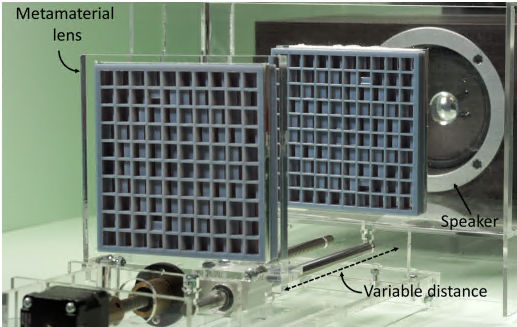| A Personal Sound Projector For $10 |
| Written by David Conrad | |||
| Sunday, 18 August 2019 | |||
|
Perhaps the "for $10" part is hype as that is just the cost of the webcam used in the tracking system, but it is low cost. Using acoustic meta-materials a team has managed to focus a beam of sound that can be delivered to a single person. Light can be focused using optically dense materials such as glass or using cleverly shaped surfaces. Sound is more difficult to focus because it has a much larger wavelength. Over the past few years researchers have managed to create prisms and lenses for sound using specially manufactured materials - meta-materials. So far there haven't been any end user applications, but this might be about to change.
Gianluca Memoli and his colleagues at the university of Sussex demonstrated what they believe to be the world’s first sound projector with an autozoom objective in a talk at SIGGRAPH 2019. So far there are no in-depth scientific papers describing the system, just a write up of the talk, so we have to guess at some of the detail. Apparently the idea came about when the team realized that they could print acoustic lenses for around $100 each, which made it possible to think of combining them with some additional technology. A webcam and a face tracking program plus an Arduino to guide the setup produces a tracking acoustic projector.
Once locked onto a person, the projector tracks them and delivers sound to them and only them. Two acoustic lenses are used to create a "telephoto" lens that can focus sound at a variable distance from the projector.
At the moment the device seems to only cover just over three octaves from 196Hz to 2093Hz, which needs to be compared to the narrow band (low-fi) telephone quality range of frequencies of 300Hz to 3400Hz. The team hopes to expand the bandwidth to be able to beam higher quality audio, but it isn't clear that this is possible or practical. It also isn't clear how practical the current device is. What distances does it work over? How much leakage is there? What could you use a working system such as this for? The most dystopian view is probably that you could track people and play suggestions for what they might like to buy. My own suggestion is to deliver a private message intended for an individual to an audience member or airplane passenger. The research team is at pains to stress that consent is needed to beam sound at a person using their system. More Information From light to sound: prisms and auto-zoom lenses Related ArticlesLearning to Sound like a Fender Hacking Alexa By Whispering In Her Ear Chirp - A New Way To Send Data To be informed about new articles on I Programmer, sign up for our weekly newsletter, subscribe to the RSS feed and follow us on Twitter, Facebook or Linkedin.
Comments
or email your comment to: comments@i-programmer.info |
|||
| Last Updated ( Thursday, 22 August 2019 ) |




